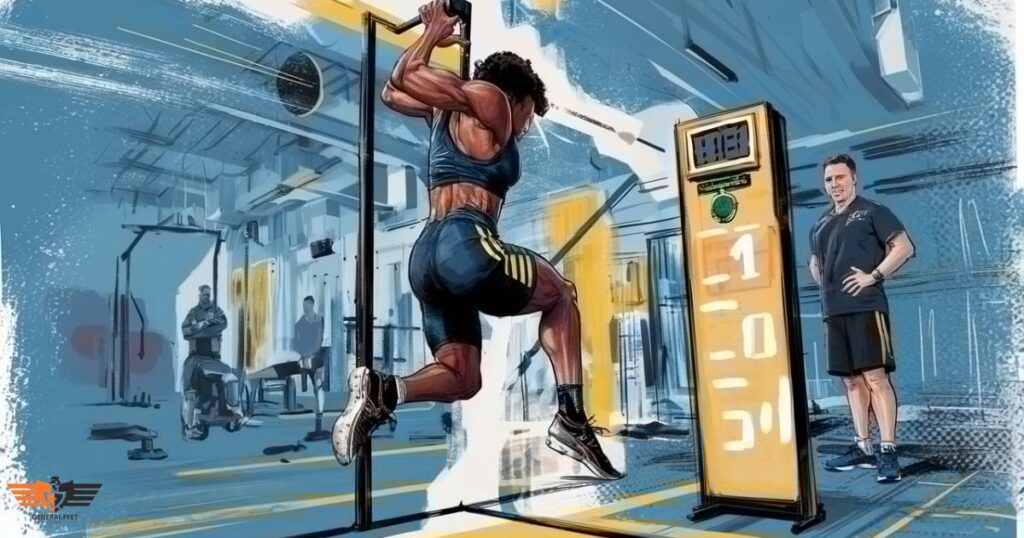Dreaming of slamming the ball through the hoop? A dunk calculator can be your secret weapon. By inputting your height, standing reach, and vertical leap, you’ll discover exactly what you need to achieve your dunking goals.
Improving your vertical jump is key to unlocking your dunking potential. Focus on strength training, explosive exercises, and plyometrics to add crucial inches to your leap. Consistency and proper technique are essential for seeing results.
Perfecting your dunk mechanics is the final piece of the puzzle. Learn to load into your jump effectively, release the ball at your peak height, and use the backboard when needed. With dedicated practice and the right approach, you’ll be throwing down thunderous dunks in no time.
Understanding the Dunk Calculator

A dunk calculator is an online tool that helps aspiring dunkers determine their potential and set realistic goals. By inputting key physical measurements, you can assess your current ability and identify areas for improvement.
The calculator uses your data to provide personalised insights, including whether you can currently dunk and how much you need to improve your vertical leap. This information is crucial for developing a targeted training plan.
Some are;
- Height
- Standing reach
- Maximum vertical leap
- Jumping position (one or two feet)
- Standing dunk height
- Running dunk potential
- Inches needed to achieve a dunk
- Estimated maximum dunk height potential
How does the Dunk Calculator Work?
Dunk calculators analyse your physical measurements to assess your dunking ability. You input key data such as height, standing reach, and maximum vertical leap, which the calculator then processes.
The tool uses this information to determine crucial metrics like your current dunking potential and how much improvement you need. It calculates the gap between your reach and the rim height to show if you can dunk now or how close you are.
By factoring in your measurements and jump height, the calculator provides personalised insights. It estimates your potential maximum dunk height and offers guidance on improving your vertical leap to achieve your dunking goals.
Some are,
- Height
- Standing reach
- Max vertical leap
- Jumping style (one or two-foot takeoff)
- Standing dunk height
- Running dunk potential
- Inches needed to dunk
- Estimated max dunk height potential
Read Related Article…
Who Is David Njoku’s Girlfriend? Is He Dating His Daughter’s Mom?
Enhancing Your Vertical Jump Performance
Improving your vertical jump is crucial for dunking success. Focus on developing lower body strength, speed, and explosiveness through targeted exercises and training routines.
Incorporate a mix of strength training and plyometric exercises into your workout regimen. These will build muscle power, increase your ability to generate force quickly, and enhance your overall jumping ability.
Consistency is key in vertical jump training. Regularly assess your progress using reliable measurement methods, and adjust your training as needed to continue seeing improvements in your leap.
Some are,
- Strength training
- Speed drills
- Plyometric exercis
- Squats and deadlifts
- Box jumps
- Lunges
- Power cleans
- Cone hops and ladder drills
- Depth jumps and broad jumps
- Train lower body 2-3 times per week
- Include both strength and explosive exercises
- Re-test vertical jump every 4 weeks
- Gradually increase intensity and difficulty
Assessing Your Vertical Jump Ability

Accurately measuring your vertical jump is crucial for tracking progress and using dunk calculators effectively. Methods range from simple wall tests to advanced Vertec devices and smartphone apps.
Vertical Jump Test
- Stand flat-footed next to a wall
- Mark your standing reach height
- Jump as high as possible from a standstill
- Slap the wall at peak jump height
- Measure the difference between marks
- Repeat 3-5 times for accuracy
- Use best result as your vertical leap
- Warm up properly before testing
- Retest every 4 weeks to track progress
- Maintain consistent technique across tests
Vertec Device
The Vertec is a specialised vertical jump measurement tool used in professional combines and athletic facilities. It features horizontal plastic arms that pivot when struck, providing precise height measurements. The Vertec offers excellent accuracy and is widely respected in sports performance testing.
Jump Apps
Jump apps utilise smartphone technology to measure vertical leap with impressive accuracy. Apps like Vert use slow-motion video capture and AI algorithms to analyse jump height. Users simply record their jumps, and the app calculates the vertical leap automatically.
These apps offer convenient tracking, allowing athletes to log their progress over time. Many provide additional features like performance analytics, training suggestions, and comparison with other users. Jump apps are cost-effective alternatives to expensive equipment and can be used anywhere with a smartphone.
Read Related Article…
Investigating the Potential of the Plugboxlinux Gaming Platform
The Secret to Perfect Slam Dunks
The key to executing perfect slam dunks lies in a combination of physical preparation and proper technique. Develop explosive lower body strength through targeted exercises and plyometrics to achieve the necessary vertical leap.
Master the mechanics of dunking by learning to load into your jump effectively, reach your peak height before releasing the ball, and finish with authority. Practice using the backboard for easier dunks initially, and always prioritise safety by warming up properly and landing softly.
Load Into Your Jump Properly
Loading into your jump properly is crucial for maximising your vertical leap. As you approach the basket, lower your centre of gravity by bending your knees and hips. Simultaneously, swing your arms back to create potential energy.
Just before takeoff, explosively extend your legs and drive your arms upward. This coordinated movement transfers the energy from your approach into vertical lift, helping you reach your maximum jump height.
Release the Ball at the Peak
Releasing the ball at the peak of your jump is essential for successful dunking. Many beginners make the mistake of releasing too early, which reduces their effective reach and makes dunking more difficult.
Instead, focus on reaching your maximum height before bringing the ball up towards the rim. At the apex of your jump, extend your arm fully and powerfully push the ball through the hoop. This technique allows you to utilise your full vertical reach, increasing your chances of a successful and impressive dunk.
Use the Backboard
For beginners, using the backboard can significantly increase your chances of successful dunks. Approach the basket at an angle and aim to throw the ball high off the glass. This technique converts your forward momentum into upward lift, making it easier to reach the rim.
As you improve, you can gradually transition to more direct dunks. However, even experienced dunkers often use the backboard for certain types of shots, as it provides a larger target and can help maintain control during high-speed approaches.
Protect Your Body
When dunking, prioritising safety is crucial to prevent injuries and ensure long-term athletic performance. Always warm up thoroughly before attempting dunks, and focus on landing softly with bent knees to absorb impact. Avoid hanging on the rim unnecessarily, as this can lead to dangerous falls or shoulder injuries.
Listen to your body and don’t push beyond your limits too quickly. Gradually increase the difficulty of your dunks as your strength and skill improve. Remember, consistent training and smart progression are key to achieving impressive dunks while maintaining your health.
Bullet points for protecting your body:
- Always warm up properly before dunking
- Land softly with bent knees to absorb shock
- Avoid unnecessary hanging on the rim
- Progress gradually in dunk difficulty
- Use proper form to prevent strains or sprains
- Strengthen core and stabilising muscles
- Wear appropriate, supportive footwear
- Allow adequate rest and recovery between intense sessions
How Much Vertical to Dunk at 6 Feet?

At 6 feet tall, most people need a vertical leap of about 14 inches to dunk. This is because the average standing reach for a 6-foot person is around 7 feet 10 inches, and the rim is at 10 feet.
An exceptional vertical jump for someone 6 feet tall would be 20+ inches. To achieve this, focus on leg strength training and plyometric exercises to improve your leaping ability.
What is Your Vertical if You Can Touch Rim at 5’8?
If you’re 5’8″ and can touch the rim, your vertical leap is likely around 26 inches. This calculation takes into account the average standing reach for someone 5’8″ (about 7’4″) and the standard rim height of 10 feet.
To improve your vertical and potentially dunk, aim to increase your max vertical to 30+ inches. This can be achieved through targeted training, including squats, power cleans, and plyometric exercises.
Read Related Article…
Who is Can Yaman’s Wife?
How High Do You Have to Jump to Dunk at 5’10?
At 5’10” you’ll typically need a vertical leap of about 20 inches to dunk a basketball. This is because the average standing reach for someone this height is around 7’8″, leaving about 28 inches to make up between your reach and the 10-foot rim.
Achieving this vertical jump is challenging but attainable with dedicated training. Focus on lower body strength exercises, plyometrics, and proper jumping technique. With consistent effort, you can increase your vertical leap and potentially achieve your dunking goals at 5’10”.
How High Do You Have to Jump to Dunk at 6’2?

At 6’2″, you’re already quite close to dunking. The average standing reach for someone this height is around 8’0″, leaving only about 24 inches to cover to reach the 10-foot rim. This means you need a vertical leap of at least 12 inches to achieve a basic dunk.
However, to dunk comfortably and with authority, aim for a vertical leap of 20 inches or more. This extra height will allow you to perform more impressive dunks and give you a better chance of success in game situations. With focused training on leg strength and explosiveness, most 6’2″ individuals can achieve dunking ability relatively quickly.
Frequently Asked Questions
How much vertical leap do I need to dunk at 6 feet tall?
At 6 feet tall, you typically need about a 14-inch vertical leap to dunk.
Can a person who is 5’8″ dunk a basketball?
Yes, a 5’8″ person can dunk, but it’s challenging and requires an exceptional vertical leap of around 26+ inches.
What’s the difference between standing reach and vertical jump?
Standing reach is how high you can reach with feet flat on the ground. Vertical jump is how high you can jump from a standing position.
How often should I test my vertical jump during training?
Test your vertical jump about every 4 weeks during training to track progress effectively.
Is it better to use a wall test or a jump app to measure vertical leap?
Both methods have merits. Wall tests are simple and accessible, while jump apps offer more detailed analysis. Choose based on your needs and available resources.
Final Thoughts
Mastering the slam dunk requires a combination of physical attributes, dedicated training, and proper technique. By utilising dunk calculators and consistently working on your vertical jump, you can make steady progress towards your dunking goals.
Remember that improvement takes time and patience. Stay committed to your training regimen, regularly assess your progress, and adjust your approach as needed. With persistence and the right strategies, you’ll be throwing down impressive dunks sooner than you might think.
Read Related Article..

Admin of GeneralFet.com, dedicated to providing diverse and insightful content on a wide range of general topics. Passionate about sharing knowledge and fostering a community of curious minds.








